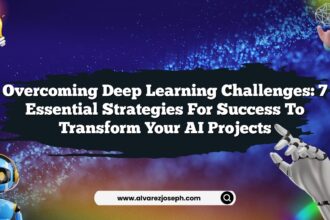Imagine waking up one day to find you’ve become the wizard of artificial intelligence. You wave your virtual wand, and suddenly, your projects are not just functional; they’re groundbreaking. The world of deep learning is vast and full of surprises, and mastering it can feel like climbing Everest without oxygen. But don’t worry; we’re not scaling mountains here. Instead, we’ll explore ten essential techniques that will not only elevate your AI skills but also make your journey thrilling.
Embrace the Power of Neural Networks
At the heart of deep learning lies neural networks, the complex structures that mimic human brain function. Understanding how these networks work is like knowing the secrets of a magic trick.
Neural networks consist of layers of nodes, or neurons, which are interconnected. The input layer takes in the data, hidden layers process it, and the output layer delivers the result. This hierarchical structure allows neural networks to learn from vast amounts of data, making them exceptionally powerful.
Imagine teaching a toddler to recognize cats by showing them thousands of pictures. Eventually, they’ll identify a cat, even if it’s hiding behind a tree or wearing a funny hat. Similarly, neural networks learn from data inputs, adjusting their internal parameters to improve accuracy.
But don’t just take my word for it. Look at how companies like Google and Facebook utilize deep learning for image and speech recognition. Isn’t it fascinating how such intricate systems can be trained to recognize what they’ve never seen before?
Mastering Backpropagation: The Learning Algorithm
Let’s talk about backpropagation, the unsung hero of neural networks. It’s like the GPS that recalibrates your route when you take a wrong turn.
Backpropagation is an algorithm used to minimize errors in a neural network. Here’s how it works: once the network produces an output, it compares it to the expected result. If there’s a discrepancy, backpropagation sends the error back through the network, adjusting the weights of the connections to decrease that error in future predictions.
Think of it like a coach analyzing game footage. If a player keeps missing shots, the coach identifies the problem areas and guides them to improve. This iterative process is crucial for refining the model. Without it, your network would be like a car without brakes—going fast but heading for disaster.
Data Preprocessing: The Unsung Hero
Before diving into the exciting world of training models, you must first prepare your data. Data preprocessing is the essential step that ensures your machine learning model doesn’t crash and burn.
Imagine you’re hosting a dinner party. You wouldn’t serve burnt food, right? Similarly, feeding raw, unprocessed data into a neural network can lead to poor results. Techniques like normalization, encoding categorical variables, and handling missing values can transform your dataset into a gourmet meal for your model.
For instance, standardizing numerical features ensures that they all contribute equally to the model’s learning process. In other words, your model won’t get distracted by a particularly loud data point—it’ll be able to focus on the big picture.
Regularization: Avoiding Overfitting
You’ve trained your model, and it’s performing brilliantly on your training dataset. But wait! When you test it on new data, it flops like a fish out of water. This is a classic case of overfitting.
Overfitting occurs when your model learns the training data too well, capturing noise and outliers. It’s like cramming for a test without understanding the subject. To prevent this, you can apply techniques like L1 or L2 regularization, which add a penalty for larger coefficients in your model.
Imagine running a race. If you’re carrying extra weight, you’ll slow down. Regularization trims the unnecessary fat, helping your model generalize better to unseen data. The result? A model that performs well both in training and in the wild.
Hyperparameter Tuning: The Art of Optimization
Now we’re diving into the art of hyperparameter tuning—the delicate balance of finding the sweet spot that optimizes your model’s performance.
Hyperparameters are the settings you configure before training your model. They’re not learned during training but set beforehand, making them crucial. Think of them like the dials on a fancy coffee machine—adjust them right, and you get the perfect brew. Adjust them wrong, and you’re left with a watery disaster.
Techniques like grid search and random search are commonly used for tuning these parameters. They can feel like searching for a needle in a haystack, but the results can be transformative. A well-tuned model can drastically improve accuracy, just like a finely tuned instrument sounds heavenly.
Convolutional Neural Networks: Understanding Images
When it comes to image processing, Convolutional Neural Networks (CNNs) are the rock stars of deep learning. If neural networks are the foundation, CNNs are the skyscrapers reaching for the stars.
CNNs specialize in analyzing visual data, and their architecture is designed to capture the spatial hierarchy of images. They use layers of convolutional filters that scan the image for features, such as edges, shapes, and textures. It’s like piecing together a puzzle; each filter helps identify a part of the whole picture.
For example, when you upload a selfie and a social media app tags your friends, it’s likely using CNNs to recognize faces. The beauty of CNNs lies in their ability to learn these features automatically, removing the need for manual feature extraction.
Recurrent Neural Networks: The Sequence Masters
When dealing with sequences—like time series data or text—you need a different approach. Enter Recurrent Neural Networks (RNNs), the masters of handling sequential information.
RNNs have loops that allow information to persist, enabling them to remember previous inputs. This characteristic makes them perfect for tasks like language modeling and speech recognition. It’s akin to remembering the plot of a movie as it unfolds—each scene builds on the previous one.
But tread carefully; RNNs can also struggle with long sequences, leading to issues like vanishing gradients. Techniques like Long Short-Term Memory (LSTM) networks help mitigate these challenges, ensuring that your model retains important information over longer spans.
Transfer Learning: Building on Previous Success
What if I told you that you could build your model upon the success of others? That’s the essence of transfer learning—leveraging pre-trained models to kickstart your projects.
Instead of starting from scratch, you can take a model that has already learned from vast datasets and fine-tune it for your specific task. It’s like taking a well-written book and editing it to fit your style. The heavy lifting has already been done; now, it’s about personalizing it for your audience.
Common frameworks like TensorFlow and PyTorch offer pre-trained models that you can adapt. This approach saves time and resources, allowing you to harness the power of deep learning without the daunting task of training a model from the ground up.
Keep Evolving: Staying Updated with Trends
The world of deep learning is constantly evolving, much like fashion trends. What’s in vogue one year might be out the next. Thus, staying updated is crucial for mastering this field.
Engage with online communities, follow influential blogs, and participate in courses. You never know when a groundbreaking technique or an innovative framework will appear. Keeping your finger on the pulse of the latest developments will ensure your skills remain sharp and relevant.
And remember: the learning never stops. Embrace the journey, and be open to new ideas, just like a curious child exploring a new playground.
Quick Summary
- Neural Networks are the backbone of deep learning, emulating brain function.
- Backpropagation helps minimize errors during the learning process, refining models.
- Data Preprocessing transforms raw data into a usable format for models.
- Regularization prevents overfitting, ensuring models generalize well.
- Hyperparameter Tuning optimizes model performance, akin to fine-tuning a coffee machine.
- Convolutional Neural Networks (CNNs) excel in image processing by capturing spatial hierarchies.
- Recurrent Neural Networks (RNNs) handle sequences, remembering previous inputs.
- Transfer Learning allows leveraging pre-trained models for faster development.
- Staying Updated with trends is crucial for maintaining relevance in deep learning.
- Embrace the learning journey; it’s as exciting as a roller coaster ride!
Frequently Asked Questions
What are neural networks, and why are they important?
Neural networks are computational models that mimic the way human brains operate. They are crucial for deep learning, enabling machines to learn from data without being explicitly programmed.
How do I prevent overfitting in my model?
You can prevent overfitting by using techniques such as regularization, cross-validation, and simplifying your model architecture.
What is the difference between CNNs and RNNs?
CNNs are designed for spatial data like images, while RNNs are suited for sequential data, such as time series or text.
How can I improve my model’s performance?
You can improve your model’s performance through hyperparameter tuning, data augmentation, and using techniques like ensemble learning.
What is transfer learning, and how does it work?
Transfer learning involves taking a pre-trained model and fine-tuning it for a specific task, allowing you to benefit from the learned features of a larger dataset.
How often should I update my knowledge in deep learning?
Given the rapid advancements in the field, you should aim to update your knowledge regularly—think of it as keeping your software up to date for the best performance.
With these techniques under your belt, you’re well on your way to mastering deep learning. The journey may be challenging, but remember, it’s not just about the destination—it’s about the exciting ride along the way!












